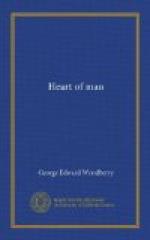in Aeschylus, Sophocles, and Euripides; in England
less clearly in Marlowe, Shakspere, and Webster.
How monstrous in the latter did tragedy necessarily
become! yet more repulsive in his tenderer companion-spirit,
Ford. In Greek sculpture, passing into convulsed
and muscular forms or forms of relaxed voluptuousness,
in Italian painting, in the romantic poetry of this
century with us, the same stages are manifest.
Age parallels age. Tennyson in artistic technique
is Virgilian, we are aware of the style; but both
Virgil and Tennyson remain classic in matter, in universality,
and the elemental in man. Browning in substance
is Euripidean, being individualistic, psychologic,
problematic, with special pleading; classicism had
departed from him, and left not even the style behind.
The great opposition lies in the subject of interest.
Is it to know ourselves in others? Then art which
is widely interpretative of the common nature of man
results. Is it to know others as different from
ourselves? Then art which is specially interpretative
of abnormal individuals in extraordinary environments
results. This is the opposition between realism
and idealism, while both remain in the limits of art,
as these terms are commonly used. It belongs to
realism to tend to the concrete of narrow application,
but with fulness of special trait or detail.
It belongs to idealism to tend to the concrete of broad
application, but without peculiarity. The trivial
on the one hand, the criminal on the other, in the
individual, are the extremes of realistic art, while
idealism rises to an almost superhuman emphasis on
that wisdom and virtue, and the beauty clothing them,
which are the goal of a nation’s effort.
Race-ideas, or generalizations of a compact and homogeneous
people summing up their serious interpretations of
life, their moral choices, their aspiration and hope
in the lines of effort that seem to them highest,
are the necessary matter of idealism; when these are
expressed they are the Greek spirit, the Roman genius,
great types of humanity on the impersonal, the national
scale. As these historic generalizations dissolve
in national decay, art breaks up in individual portrayal
of less embracing types; the glorification of the
Greek man in Achilles yields place to the corruptions
of the homunculus; and in general the literature of
nationality gives way to the unmeaning and transitory
literature of a society interested in its vices, superstitions,
and sensations. In each age some genius stands
at the centre of its expression, a shining nucleus
amid its planetary stars; such was Dante, such Virgil,
such Shakspere. Few indeed are the races that
present the spectacle of a double-sun in their history,
as the Hebrews in Psalm and Gospel, the Greeks in
Homer and in Plato. And yet, all this enormous
range of life and death, this flowering in centuries
of the human spirit in its successive creations, reposes
finally on the more or less general nature of the
concretes used in its art, on their broad or narrow




